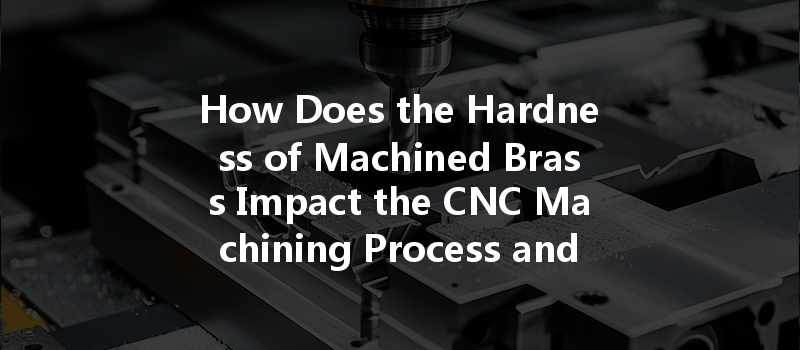Did you know that brass, an alloy primarily composed of copper and zinc, can have a hardness rating that varies significantly based on its composition and processing method? This variability can lead to crucial implications for how brass is machined, especially in CNC applications. As CNC machining continues to gain prominence across industries—from aerospace to automotive—understanding how the hardness of machined brass affects the process is vital for engineers, manufacturers, and designers alike.
—
What is CNC Machining?
Computer Numerical Control (CNC) machining is a manufacturing process whereby pre-programmed computer software dictates the movement of factory tools and machinery. The process allows for a high degree of precision and repeatability, making it ideal for mass production and intricate designs. In CNC machining, tools can perform various operations, including drilling, milling, and turning, which makes it a versatile method for producing components out of diverse materials, including metals like brass.
The Importance of Material Properties
When it comes to CNC machining, understanding the material properties is crucial for achieving the desired product outcome. This understanding extends beyond just the type of material used; it includes knowing how various factors—such as hardness—can influence the machining process.
—
What Is Brass?
Brass is a type of metal alloy usually made from copper and zinc. The proportions of these metals can vary, leading to different types of brass (such as yellow brass, red brass, and more). Each type exhibits distinct characteristics, including hardness.
The Hardness Scale and Its Relevance
Hardness is a measure of a material’s resistance to deformation. For metals, hardness can be assessed using several scales, including Rockwell, Vickers, and Brinell hardness tests. Each of these methods provides a different perspective on the material’s hardness and wear resistance, which are important for machining applications.
Factors Affecting Brass Hardness
Several factors can influence the hardness of brass, including:
—
Step-by-Step Breakdown of CNC Machining
CNC machining generally follows these steps:

Technologies and Tools Used
CNC machining employs various tools based on the material and the required processes, including:
Selecting the right tool is critical, especially when working with materials of varying hardness.
—
Impact on Tool Wear
Higher hardness levels in brass can lead to increased tool wear. This is particularly relevant for tools made from softer materials, which can result in the need for frequent tool changes. As the hardness of brass goes up, more robust tooling materials, such as carbide or high-speed steel, are often required to mitigate this issue.
Effects on Surface Finish
The surface finish of a machined part is often a critical quality aspect. Harder brass can lead to a rougher finish unless proper techniques and tooling are employed. Understanding the right feed rates and cutting speeds is essential for achieving an optimal surface finish.
Changes in Machining Parameters
As the hardness of brass changes, so too must the machining parameters. Modifications may include:
—
Choosing the Right Tools
Tool selection is paramount for successful CNC machining of brass. For harder variants, tools made from carbide or cobalt are often recommended due to their strength and wear resistance. Additionally, specialized coatings like TiN (Titanium Nitride) can enhance tool longevity.
Optimizing Machine Settings
Adjusting machine settings based on the specific brass alloy being machined can lead to better outcomes. Here are key settings to optimize:
Best Practices for Machining Brass
Implementing best practices can notably enhance the machining process:
—
Successful Machining of Hardened Brass Components
Case studies can provide unique insights into overcoming challenges related to machining brass with varying hardness. One company successfully switched to carbide tooling when faced with high wear rates on softer tools during the machining of hardened brass components, significantly reducing downtime.
Lessons Learned in Market Applications
From the automotive industry to precision instrument crafting, interviews with industry experts reveal the importance of recognizing the specific hardness levels of the brass being machined and adapting practices accordingly. These insights can serve as a template for other industries similarly utilizing brass in their manufacturing processes.
—
Understanding how brass hardness affects CNC machining is not just an academic exercise; it provides critical insights that can significantly enhance manufacturing efficiency, product quality, and ultimately, cost-effectiveness. By choosing the right tools, optimizing machining processes, and adhering to best practices, manufacturers can mitigate the challenges posed by harder brass materials.
Why This Blog Is Worth Your Attention
The information shared in this blog is essential for anyone linked to the CNC machining industry, especially as innovations and material science continue to evolve. By equipping yourself with knowledge of how material properties affect machining operations, you can make more informed decisions that enhance both product outcomes and operational efficiencies. Embracing these insights can lead to technological advancements in how we approach and utilize CNC machining globally.
In conclusion, as CNC machining becomes increasingly critical across various sectors, understanding the implications of material hardness cannot be overstated. This knowledge is not just cognitive; it is actionable and can make the difference between a project’s success and its failure. The importance of thorough research, innovative solutions, and real-world application is essential in navigating the complexities of modern manufacturing.
—






